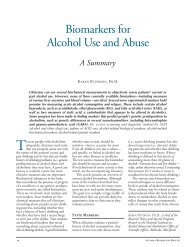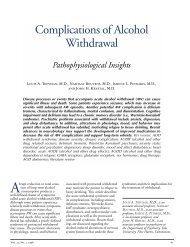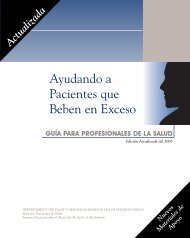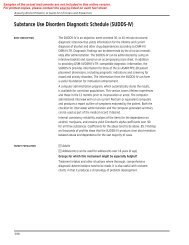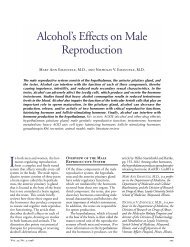Alcohol Syndrome (FAS) and Other Alcohol-Related Birth Defects
Alcohol Syndrome (FAS) and Other Alcohol-Related Birth Defects
Alcohol Syndrome (FAS) and Other Alcohol-Related Birth Defects
You also want an ePaper? Increase the reach of your titles
YUMPU automatically turns print PDFs into web optimized ePapers that Google loves.
“H<strong>and</strong>s-on Science: Brine Shrimp Experiment”<br />
Instructions<br />
I. Question to be explored: Does alcohol damage a developing organism?<br />
II. Hypothesis or prediction: <strong>Alcohol</strong> will decrease the number of brine shrimp that will hatch from<br />
their eggs.<br />
III. Experimental Design<br />
Materials<br />
1 Brine shrimp egg pack<br />
1 Screw-capped jar containing premeasured marine salt<br />
4 60 mm Petri dishes with lids<br />
3 1 ml Pipets<br />
1 5 ml Pipet<br />
4 Toothpicks<br />
1 Ruler<br />
1 Magnifying glass (dissecting microscope, optional)<br />
Bottled spring water (recommended) or *tap water that is dechlorinated<br />
1 ml of 100% Ethanol (alcohol; ethyl alcohol)***<br />
***Important information regarding ethanol (alcohol) to be used for this experiment.<br />
1. Absolute (100% also known as 200 proof), non-denatured grain alcohol is required. Do<br />
not use rubbing alcohol, or ethanol that is denatured with a contaminant such as<br />
benzene.<br />
2. If you elect to substitute an over-the-counter alcoholic beverage, be sure to note the<br />
“proof” <strong>and</strong> adjust volumes accordingly. For example, should you utilize a 100 proof<br />
alcoholic beverage such as some vodkas or bourbons, simply double the volume of<br />
alcohol added to each dish. For the 1% condition use 0.2 mls; for the 2.5% use 0.5 mls<br />
<strong>and</strong> for the 5% condition use 1.0 mls.<br />
3. In order to keep volumes reasonably small, we recommend that you use alcoholic<br />
beverages that are greater than 80 proof. Particularly useful is 190 proof grain alcohol<br />
(95% ethanol) which is readily obtainable <strong>and</strong> can be delivered at volumes that are<br />
virtually the same as those for 100% ethanol (For the 1% condition use 0.1 mls; for the<br />
2.5% condition use 0.25 mls <strong>and</strong> for the 5% condition use 0.5 mls.)<br />
4. <strong>Alcohol</strong>ic beverages suitable for this experiment can be obtained by adults from local<br />
alcoholic beverage suppliers or from on-line liquor stores.<br />
Procedures<br />
Day 1. Preparation.<br />
This experiment requires dechlorinated water. The day before the start of the<br />
experiment, fill a 500-1000 ml container with tap water <strong>and</strong> leave out overnight,<br />
uncovered. This will dechlorinate the water. *The effectiveness of this<br />
dechlorination method can be variable depending upon the chemical treatment of<br />
a given water supply. Alternatively, bottled spring water, available in most<br />
grocery stores, can be used successfully in this experiment. (Tip: To improve<br />
brine shrimp egg hatching, aerate the water overnight beginning on Day 1 by<br />
using an airstone attached to an aquarium pump.)<br />
Day 2—Set up experiment.<br />
1. Add 500 mls of dechlorinated water to the screw-capped jar with the<br />
premeasured marine salt, or mix with 12g (1 Tablespoon) of marine salt.<br />
Secure the cap <strong>and</strong> shake vigorously to dissolve. Using a 5 ml pipet, transfer<br />
10 mls of the marine salt solution into each of the four 60 mm petri dishes.<br />
2. Label the bottoms (lids can get mixed up) of the petri dishes 1 through 4.



